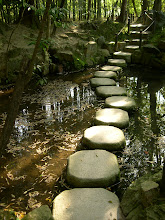The blogosphere has been buzzing recently with reaction to Debito Arudou's asinine column
Once a 'gaijin', always a 'gaijin'. Showing a dizzing level of intellectual dishonesty--or perhaps just plain stupidity--Arudou likens the word "gaijin" (written 外人, which is short for 外国人, meaning "outside country person") to the "n-word" in English. He writes:
Question: "What do you call a black man with a Ph.D. in neurobiology from Harvard who works as a brain surgeon at Johns Hopkins, earns seven figures a year, and runs one of the world's largest philanthropies?"
Answer: "N--ger."
Hardy har. Now let's rephrase.
Question: "What do you call a white man with degrees from top-tier schools who has lived in Japan for more than two decades, contributes to Japanese society as a university educator, is fluent in Japanese, and has Japanese citizenship?"
Answer: "G--jin."
I don' t know if Arudou was up against a deadline--perhaps the hot summer got to him--I'm not sure, but his sloppiness in dealing with a potentially enlightening subject is astounding.
Take, for example, this next quote:
Nobody who knows I'm a naturalized Japanese citizen calls me a gaikokujin anymore — it's factually incorrect. But there are plenty of people (especially foreigners) who don't hesitate to call me a gaijin, often pejoratively.
Thus gaijin is a caste. No matter how hard you try to acculturate yourself, become literate and lingual, even make yourself legally inseparable from the putative "naikokujin" (the "inside people," whoever they are), you're still "not one of us."
Let's look at the logic here. "Nobody who knows I'm a naturalized Japanese citizen calls me gaikokujin anymore. . ." Who are 'nobody'? Japanese? foreigners? I ask because in the next line he says "plenty of people [not nobody] (especially foreigners) who don't hesitate to call me a gaijin. . ." I guess Arudou is trying to make a point about the distinction between 'gaikokujin' and 'gaijin', but it's muddled.
Next, Arudou talks about the struggle to acculturate (a word I'm uncomfortable with anyway. . .how do we 'acculturate'?). No matter how hard you try, says Arudou, "you're still 'not one of us'". Didn't he just say that "especially foreigners" pejoritively call him 'gaijin'? Who or what, exactly, is Arudou threatened by? He seems to want to talk about Japanese notions of homogeneity, but references foreigners use of the term 'gaijin'.
Finally, I find it hard to reconcile Arudou's argument with the respect that I often feel from Japanese. Even though I'm a 'gaijin' people consider my social status when addressing me and interacting with me. Moreover, even people who don't know my particular social status (which isn't anything special by the way) will add 'san' to 'gaijin' (gaijin-san) when addressing me; a sure sign of no ill-intentions.
Arudou's knee-jerk reaction to the term 'gaijin' is trivial at best and extremely damaging at worse. I only wish he didn't have such a prominent public platform with which to broadcast his myopic assessment. It's a disservice to those who are not familiar with the history of Blacks in America, not to mention those who are the carriers of that history, to liken the word 'gaijin' to the 'n-word'--the comparison is dishonest and doesn't hold any water.
Link to Arudou's original column.
Link to responses to the column.
 http://www.japantimes.co.jp/images/photos2008/nn20080831a4a.jpg
http://www.japantimes.co.jp/images/photos2008/nn20080831a4a.jpg For those who don't know samba, most of the outfits are quite skimpy and t-back bottoms are the norm. Also, for those who don't know--Japan is quite famous for chikan, and for odd-varieties of chikan. Anyway, the whole thing was almost too much to take. Some of these lecherous folks had arrived at the wee hours of the morning to secure a good spot for their ass hunting. What surprised me most was that there were quite a few older women getting in on the action too (apparently they sell the photos to websites and magazines--yuck).
For those who don't know samba, most of the outfits are quite skimpy and t-back bottoms are the norm. Also, for those who don't know--Japan is quite famous for chikan, and for odd-varieties of chikan. Anyway, the whole thing was almost too much to take. Some of these lecherous folks had arrived at the wee hours of the morning to secure a good spot for their ass hunting. What surprised me most was that there were quite a few older women getting in on the action too (apparently they sell the photos to websites and magazines--yuck).


















